By Griffin Stead and Miles McFarlane
When one thinks of the Muslim World, Islamic strongholds which come to mind typically are the middle east, North Africa, or Western Asia. Islam’s spread overland certainly allowed the regions surrounding the Arabian peninsula, the birthplace of Islam, to become antiquated with the religion early on. There is one final region left out, a country and identity that has amassed the largest population of Muslims in the world. Welcome to Indonesia, where 200+ million Muslims reside, existing far away from the the religion’s hegemon. We chose to look into a part of Indonesia’s Islamic history due to the severe lack of information on the topic. Scrounging for any details available from the few academic sources found, we aim to raise awareness to this grossly under appreciated piece of history.
For this project specifically, we tasked ourselves with answering the question of: ‘what factors make Indonesian Islamic art unique when compared to Islamic art from the Middle East?’ Exploring Indonesian Islamic art helps answer the question of what Asian art is because it shines a light on a significantly overlooked facet of Asian Art. It allows us to broaden our exposure to and understanding of both Asian art and art as a whole.
Indonesia is unique for being an island nation which is far away from any other Islamic-dominated country. The unique way in which the religion was spread was through economic trade with Indian and Arab merchants. The variety of small coastal communities from the 14th century and on were exposed to these Muslim traders, primarily coming from India. Over time, the ruling classes which controlled the ports, adopted Islam and therefore helped spread it across other social ranks. Notably, Buddhism had found its way to Indonesia many centuries prior to Islam via Indian traders, being a dominant religion. Buddhism is a very spiritual religion which aided in Islam’s spread due to the sect which flourished; Sufism. Like any religion, there are many different sects to Islam. Sufism specifically is a mystical version of Islam that emphasis one’s personal connection with Allah through your spirit. These parralells allowed Sufi preachers and merchants from India, where Sufism was dominant, to more effectively convert the Buddhist locals. Specifically, priests emphasized the conversion of people by becoming connected to the foreign culture (Indonesia in this case), which allowed them to become accepted into society and incorporate local traditions into Islam’s identity. Overtime Buddhism was completely replaced by Islam and is no longer prevalent in the island nation.
The images provided below are almost all we could find for free online. The MET for example contains only several thinly described pieces. Not even Indonesia has much in the way of dedicated collections, with only a single museum in the entire country dedicated to Islamic Art (and unfortunately lacking an online database). Nevertheless, here is our attempt to understand the unique aspects of Indonesian Islamic Art.
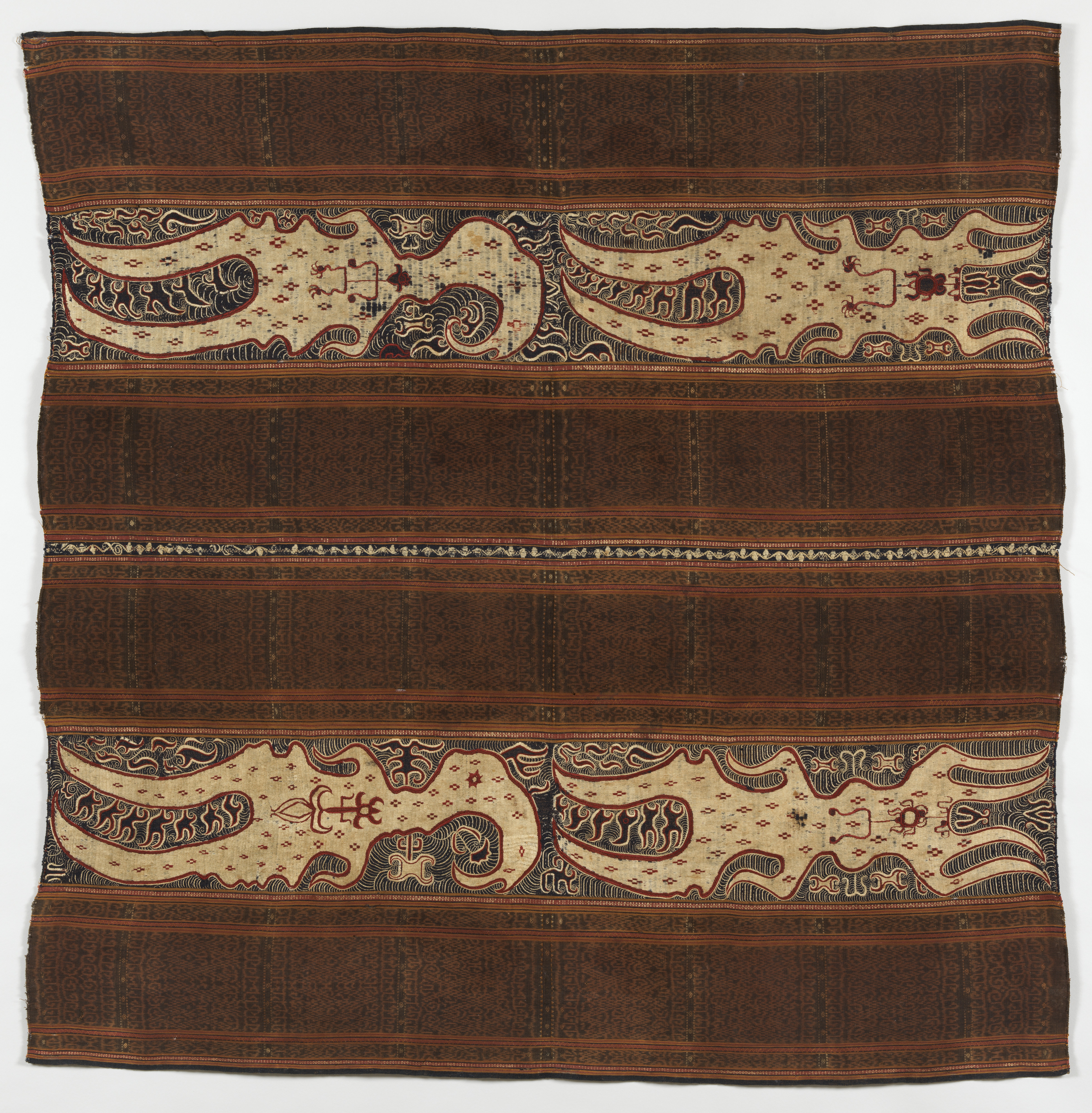
Creator: Lampung artist
Material: Cotton, silk
Size: L. 52 in. x W. 52 in. (132.1 x 132.1 cm)
Time Period: 18th century or earlier
Culture: Lampung
Location: Indonesia, Sumatra, Lampung province
Source: The Metropolitan Museum of Art
Accession Number: 1988.104.1
URL: https://www.metmuseum.org/art/collection/search/315915
Our first chosen piece is skirt with a ubiquitous design. The people of southern Sumatra, known as the Paminggir, have a local tradition of creating bespoke textiles like this. Being a center of historical maritime trade as a coastal community, these textiles portrayed an abundance of different art styles and designs. The skirt specifically is called a “Tapis”, which is a highly valued type of textile used in specific ceremonies. The detailed designs and use of the heavily sought after silk, is used to flaunt high social status. They were typically only worn by wealthy women and were so special that it would be passed down in one’s family for generations. Pre-Islamic garments typically incorporate animals and people on them to show a story planning out.
The Islamic significance is conveyed in the presentation of this specific design. A big idea of Arabian Islamic Art is the an emphasis on abstract shapes and designs. This is realized since Allah(God) is an indescribably force that cannot be detailed in word or image. As a result, religious motifs and artwork typically use abstract designs that are hard to define as a way to convey Allah’s limitless boundaries. Using the Sufi gaze, the local tradition of using animals is kept, but with a seemingly Islamic influence due to the strangeness of the creatures. The MET’s analysis believes the two-pronged shapes to be cuttlefish but leaves the door open for a different interpretation. The shapes, which curl on the ends are influenced by Islamic themes because of the indescribable nature of the present animals. It is most likely a marine animal since it is a marine community with a prominent fishing industry.
Even further, the repeating shapes and fluidity of the piece as a whole represents a key tenant of certain Tapis called “Ikat.” Ikat is an Indonesian word meaning ‘to bind’ which is used to describe the type of Tapis that uses interlocking geometric designs in the creative process.

Creator: Unknown
Inlayer: Muhammad Salih of Terumon
Material: Steel, horn, gold, wood
Size: L. with scabbard 33 1/8 in. (84.1 cm); L. without scabbard 31 1/4 in. (79.4 cm); W. 5 5/16 in. (13.5 cm)
Time Period: 1835
Culture: Malaysian, Kampung Payang and Sumatran, Aceh
Location: Kuala Berang
Source: The Metropolitan Museum of Art
Accession Number: 2014.681a, b
URL: https://www.metmuseum.org/art/collection/search/662961
This sword and hilt, called a Rudus, is specific to local peoples from northern Sumatra. This one happened to have been found in the bordering peninsula of Malaysia. The Islamic aspect is that written in gold on the sword is the name of the decorator. Purportedly this sword must have been manefactured in north Sumatra, where the sword design is native to, then transported across the Malacca straight into Malaysia to be inlaid.
This means that the sword was probably used ceremonially and was sold to a client who then had the sword beautifully stylized. Its Islamic significance is that the words on either side are in Arabic. It also ties into the significance that trade had for the diffusion of Islam across south east Asia.
Further details regarding the sword’s Islamic significance were unable to be fact checked and therefore will not be used.

Creator: Unknown
Photographer: MartijnL, from Eigen Werk Museum, Netherlands
Material: Cloth, wax
Size: Unknown
Time Period: Unknown
Culture: Javanese
Location: Yogyakarta, Indonesia
Source: Wikipedia
Accession Number: N/A
URL: https://en.wikipedia.org/wiki/Islamic_art#/media/File:Batik_Indonesia.jpg
Similar to Tapis, a type of specially-made cloth used in a wide variety of activities and circumstances in Indonesian culture. Typically used as clothing garments both formal and informal. This is specifically Islamic due to the abstract design which is uncommon. Often local cultures add mythical creatures or fauna to the patterns. While not shown in this one specifically, the use of Arabic is also employed as an artistic tool.
It is quite similar to the Tapis above in terms of its general characteristics but even more abstract.
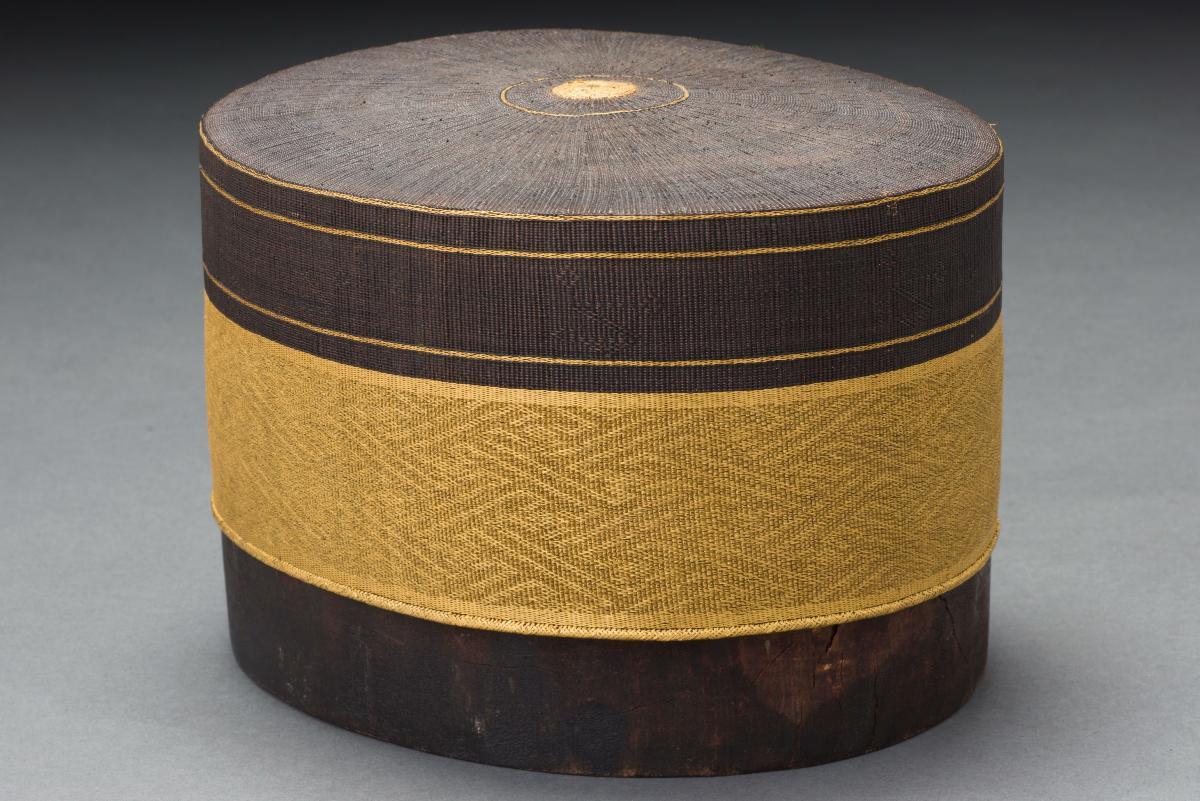
Creator: Unknown
Material: gold thread, palm fiber, wood
Size: Unknown
Time Period: 19th-early 20th century
Culture: Sulawesi
Location: Sulawesi
Source: National Heritage Board (Singapore)
Accession Number: 2008-05878
URL: https://www.roots.gov.sg/CollectionImages/1176578.jpg
Inspired by the Turkish Fes. Unknown introduction date but probably within the first century of Arab trade exposure. The name ‘Muhhamed’ is weaved into it, representing the Islamic prophet [DL: not visible in the picture?]. The use of gold is also heavily used, being a staple of historical Indonesian artistry. Said to have been worn by men of royalty.
The abundance of gold could be majorly due to the vast trade networks in Indonesian communities with the rest of the Indian Ocean. Similar to the Sogdians of central Asia who acted as a sort of middleman between China and the West. They became a culture defined by trade as many merchants travelled within their territories during the time of the silk road. This allowed their culture to amass a large amount of fine goods and exotic materials through trade. Indonesia has a very similar role but over ocean, being a barrier between far east Asia and the West. The straight of Malacca alone is one of the busiest waterways in the world.

Creator: Unknown
Photographer: Si Gam
Material: Thatched dried sago fronds, wood
Size: L. 33 ft. x W. 33 ft.
Time Period: 1414
Culture: Indonesian Islam
Location: Kaitetu Village, Maluku, Indonesia
Source: Wikipedia
Accession Number: N/A
URL: https://upload.wikimedia.org/wikipedia/commons/5/54/Masjid_Tua_Wapauwe_Kaitetu.jpg
A rural mosque present in the mountains of Maluku Island. Unique due to the materials used. Wood and other organic materials were rarely used in Middle-Eastern mosques. Stone was the preferred choice, potentially out of scarcity of wood since trees are a rare sight in the Arabian Peninsula. The roof features a two-tiered structure from the pointed top in front. This multi-layered roof style was unique to Indonesian Temples which were modelled on old Hindu temple styles. The rudimentary aesthetic is common for early islamic mosques which were not supposed to be anything more than a roof to pray over.
This happens to also be an extremely old mosque by Indonesian standards, being quite modest as well.
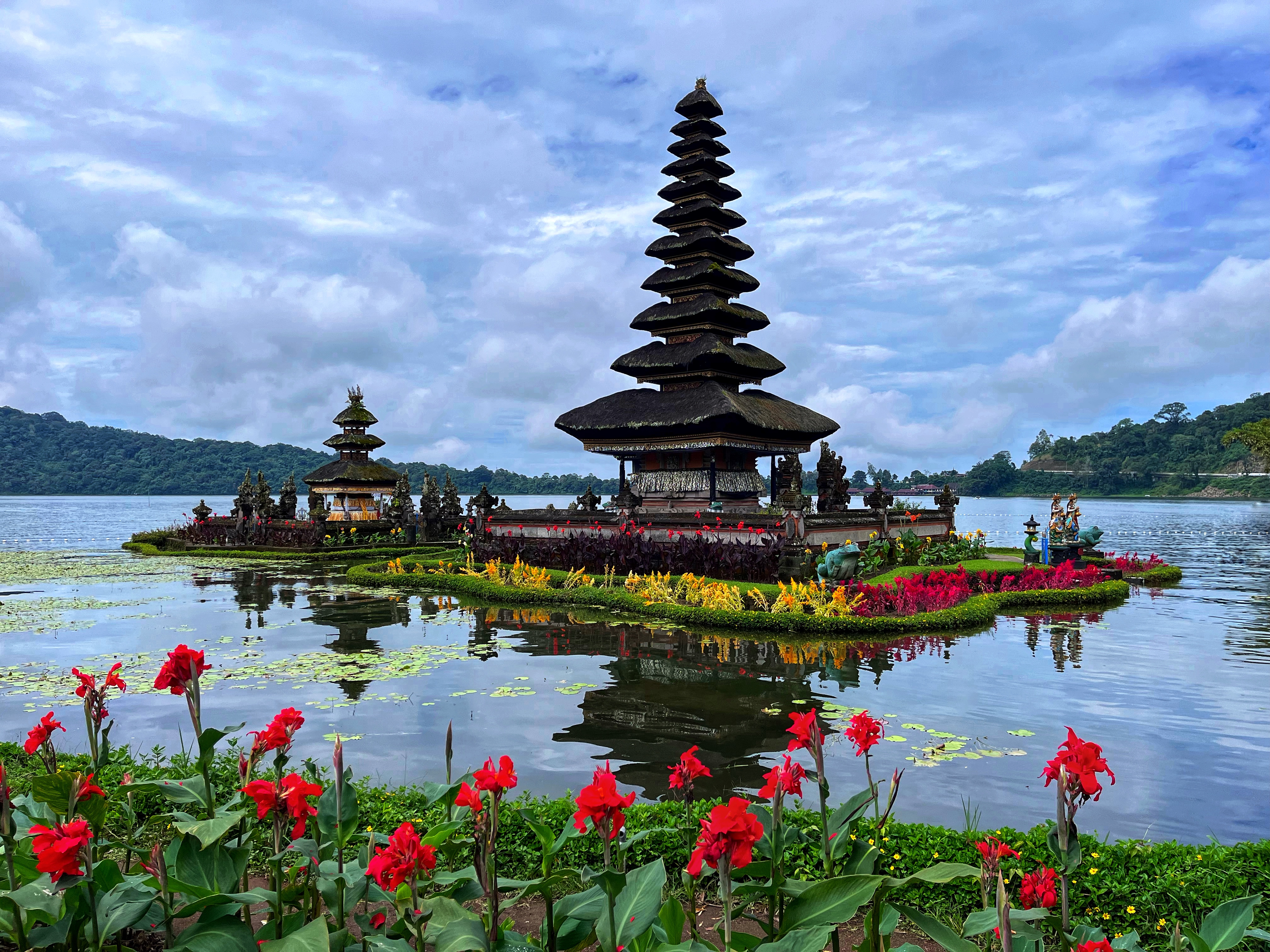
Creator: Unknown
Photographer: Luke Triton
Material: Wood, stone, palm fibres,
Size: Unknown
Time Period: 1633
Culture: Balinese
Location: Central Bali
Source: Wikipedia
Accession Number: N/A
URL: https://upload.wikimedia.org/wikipedia/commons/7/77/Pura_Ulun_Danu_Bratan%2C_2022.jpg
This is an example of a surviving Buddhist temple in Indonesia. The significance shows how Islam was able to adopt from previous traditions and styles to further the Sufi mystic approach of integration.
The stacks of roofing denote different gods to worship to. This is significant because the Islamic temple above used this same concept and only contains a single roof stack. Islam being monotheistic, only prays to Allah and therefore cannot contain more than a single stack.
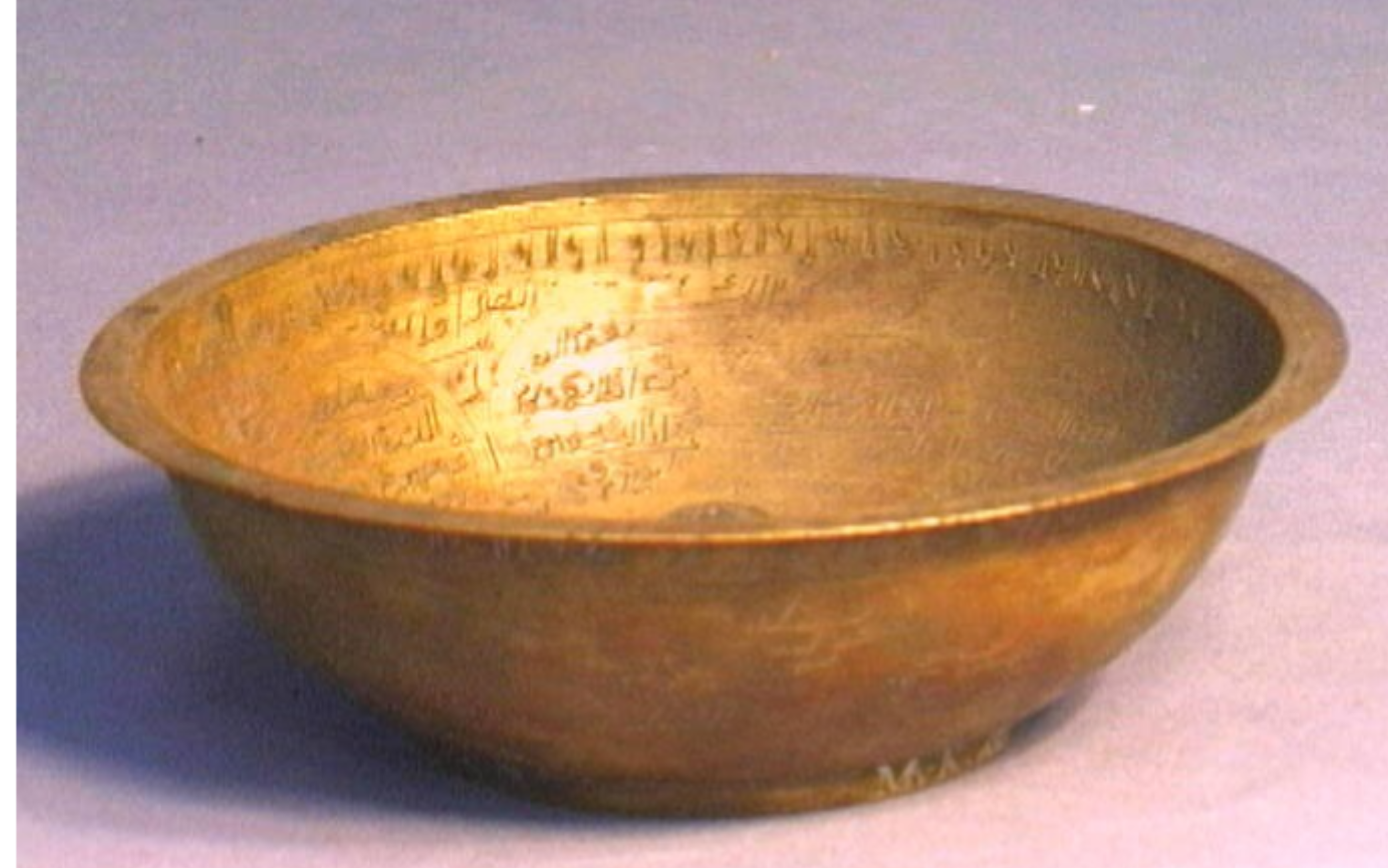
Creator: Unknown
Photographer: Unknown
Material: Bronze
Size: H. 1.97 in. x DM. 6.2 in. (5 cm. x 15.8 cm.)
Time Period: Before 1890
Culture: Javanese
Location: Surabaya, East Java, Indonesia
Source: Wereldmuseum Amsterdam
Accession Number: 1903-10-01
URL: https://hdl.handle.net/20.500.11840/705084
The bowl itself is made up of polished bronze or brass. The bowl has a small foot with what appears to be a scratch or inscription of some sort, possibly the name of the person or group that owned the bowl. From there, the wall of the bowl continuously gets wider until reaching the lip, which flares outward. On the inside of the bowl, there are passages that have been engraved into the bowl. These passages cover nearly the entire inside of the bowl and have been identified as Quranic passages.
While seemingly decorative, this bowl served as a vital tool in Islamic healing and protection rituals. The Quranic passages are believed to harbor healing and protective properties. To harness these properties, water would be poured into the bowl and over the Quranic passages and left to sit. This was done so that, over time, the water would absorb the healing and protective properties of the Quranic passages. After the absorption, the water would be consumed, thereby transferring the healing and protective benefits from the water into the person drinking it. Furthermore, metals such as bronze and brass were also believed to have some sort of healing properties, which was believed to increase the power of the ritual. While this specific bowl was used in Islamic healing rituals, the practice of using magic bowls with sacred text is not unique to Islam in the Middle East. The use of magic bowls was common among both Christians and Jews in the Middle East long before the introduction of Islam to the region. It is believed that Islam adopted the custom sometime during the twelfth century.
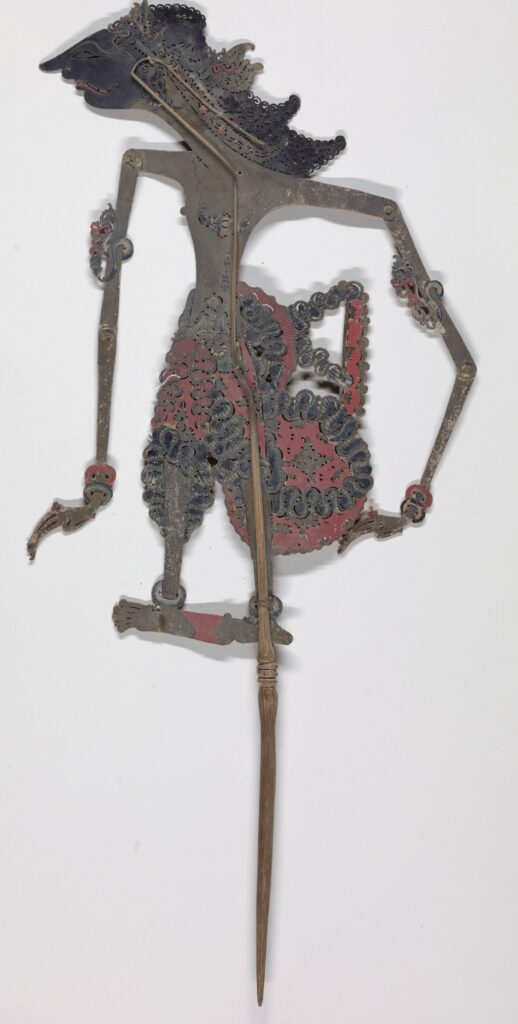
Creator: Unknown
Photographer: Cooper Hewitt
Material: Wood, painted and gilded leather
Size: 55 x 57 cm
Time Period: 19th century
Culture: Javanese
Location: Indonesia
Source: Smithsonian
Accession Number: 1935-15-1
URL: https://www.si.edu/object/shadow-puppet-wayang-kulit:chndm_1935-15-1
This is an Indonesian shadow puppet which is one of many different characters used in puppet plays across the country. They are a completely isolated and unique custom that has existed for over a millennia. It is a popular form of entertainment, with the shadow show stories touching upon almost every aspect of the human experience.
They most commonly told religious stories from old Hindu and Buddhist legends. Since the vast spread of Islam, once again Sufi doctrine came into effect to keep the traditional stories alive but with an Islamic twist. The many Hindu deities used are flipped into Sufi saints to tell the same story with a different cast.
The name of this puppetry is called Wayang and contains dozens of different subcategories. The shadow puppet provided above is not specific to an Islamic story, as it is the only open access image of a Wayang puppet we could find.
Timeline
We do not believe a timeline would fit into this project, as the pieces do not signify a change or development of Islamic art over time.
What can be said as a unifying factor is Islam’s influence in a more tangible sense beyond mere artistic expression. We found no paintings or other relics that serve purely religious reasons, further tying Islam as a secondary influence. Local tradition seems to be the most important aspect of artistic expression.
Islam’s influence is mostly attached to already established features of Indonesian culture. Its expression does not exist in a vacuum.
A lasting past
Gathering information on this specific sect of Indonesian culture proved to be a difficult task. With little open access images available and lack of scholarly sources, we have only been able to get a glimpse of what this art offers. A big reason for this is the way the Western world viewed Indonesia’s Islam.
Most of Indonesia’s islamic spread was through trade with India, and subsequently the Sufi sect. This form of Islam is shunned by the religious center of the middle-east, being mostly traditionalist and Sunni. Many Sunnis even see Sufism as a form of idolatry that is fundamentally non-Islamic. This is because a key feature of Sufism is the veneration of saints, who’s tombs people frequent in order to be blessed by their aura. This practice is most common in south Asian countries like Pakistan and Indonesia. Some people think that Allah is the only thing one should pray to, and that the appreciation of dead saints tarnishes his will.
When scholarly discourse surrounding Islam became prevalent in the 18th and 19th centuries, Indonesia was often omitted due to scholars from Europe and the Middle East seeing their version as almost not worthy of study. The idea of Indonesian Islam not being true Islam has stifled their history on a global scale.
Discovery
Viewing these art pieces together as a shared history of Islamic art, its influence is softer than we thought. Because of its ties to Sufism and a Buddhist past, Islam has become diffused into local traditions. Every art piece provided is completely original to Indonesian culture, showing that even Islamic art is still also Indonesian art.
Indonesian Islamic art is unique and different to the religion’s expression in other cultures. The spread of the religion via maritime trade and isolation of the Islands from other Islamic powers allowed it to synthesize with local traditions to great success.
It stands as another example of Asian art holding its own against foreign influence. In this way, Asian art is greater than the sum of its parts, greater than any one identity.
Bibliography
Budijanto, Bambang. “Islam in Indonesia.” Transformation 20, no. 4 (2003): 216–19.http://www.jstor.org/stable/43052572.
Fan, Pauline. “Wayang Sadat.” Mystic Music, n.d. https://mistikmuzik.org/?p=1645.
Gallini, Giulia. “Islamic Art in Indonesia – a Neglected and Problematic Heritage.” SquareKufic, January 31, 2015. https://squarekufic.com/2015/01/31/islamic-art-in-indonesia-a-neglected-and-problematic-heritage/.
George, Kenneth M. “Ethics, Iconoclasm, and Qur’anic Art in Indonesia.” Cultural Anthropology 24, no. 4 (2009): 589–621.http://www.jstor.org/stable/25619799.
“Headgear.” Roots, n.d. https://www.roots.gov.sg/Collection-Landing/listing/1176578.
Kjellgren, Eric. Oceania: Art of the Pacific Islands in the Metropolitan Museum of Art. New York and New Haven: The Metropolitan Museum of Art, 2007, pp. 218–220, no. 129.
Nuku, Maia. Oceania: The Shape of Time. New York: The Metropolitan Museum of Art, 2023, p. 40, fig. 4
O’Connell, Ronan. “How Shadow Puppets Helped Convert Indonesia to Islam.” The National , September 14, 2023. https://www.thenationalnews.com/travel/2023/09/14/how-shadow-puppets-helped-convert-indonesia-to-islam/.
Stearns, Peter N. “The Spread of Islam.” In Cultures in Motion: Mapping Key Contacts and Their Imprints in World History, 46–55. Yale University Press, 2001.http://www.jstor.org/stable/j.ctt1npng1.10.
Totton, Mary-Louise. Wearing Wealth and Styling Identity: Tapis from Lampung, South Sumatra, Indonesia. Hanover: Hood Museum of Art, Dartmouth College, 2009.
Trivedi, Sonu. “Early Indian Influence in Southeast Asia: Revitalizing Partnership between India and Indonesia.” India Quarterly 66, no. 1 (2010): 51–67.http://www.jstor.org/stable/45072986.
Wereldmuseum Rotterdam. (n.d.). Magic Bowl with Arabic Inscriptions. Weraldmuseum Rotterdam Collection. https://hdl.handle.net/20.500.11840/705084